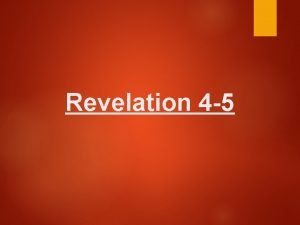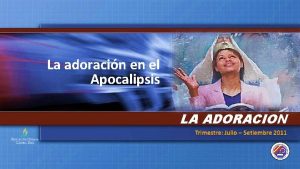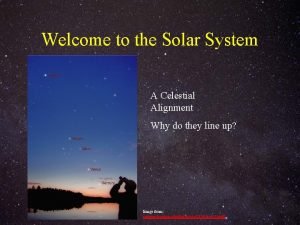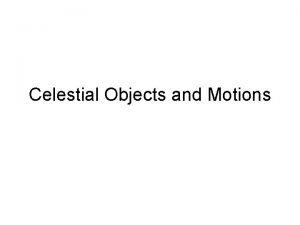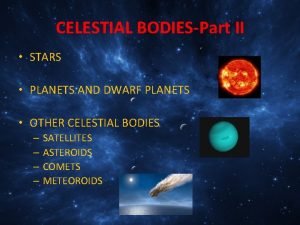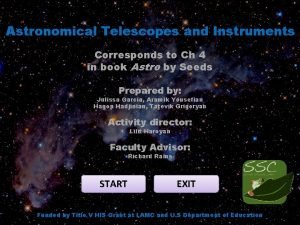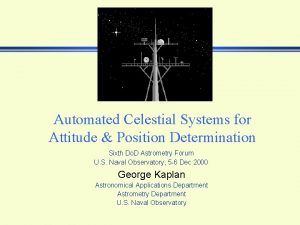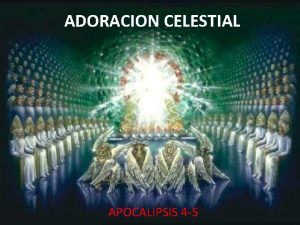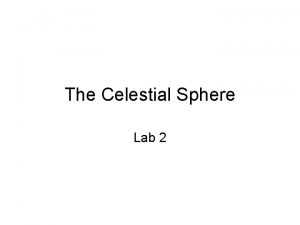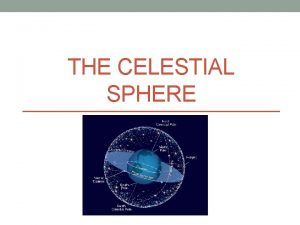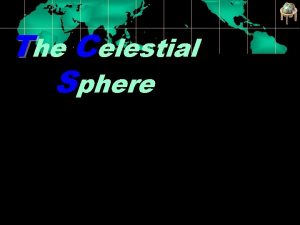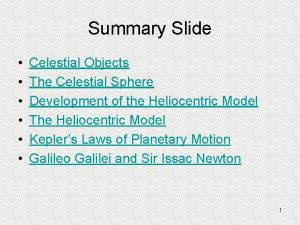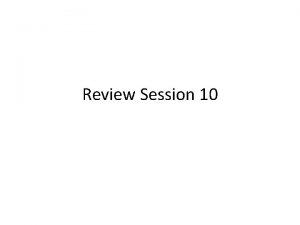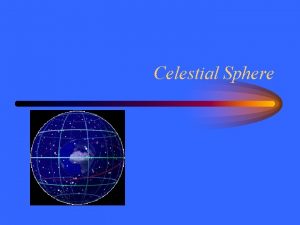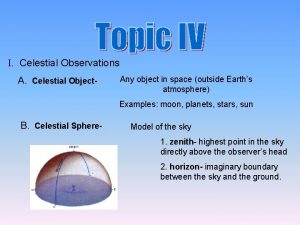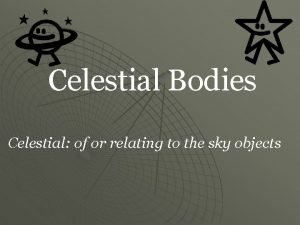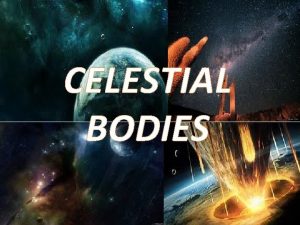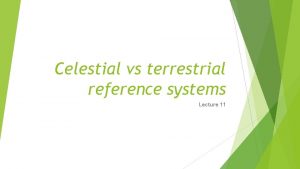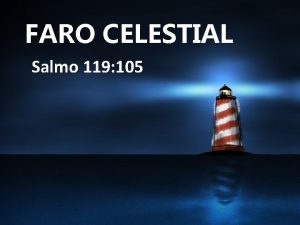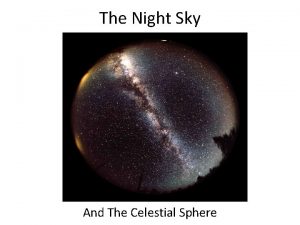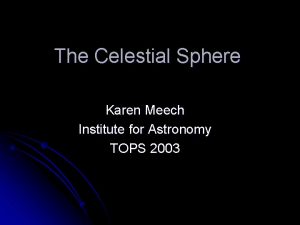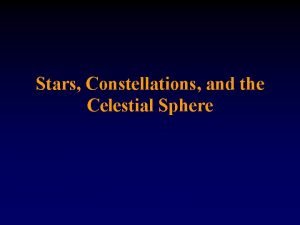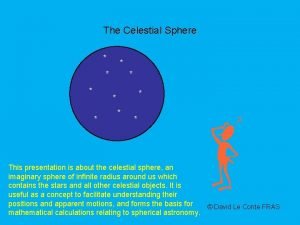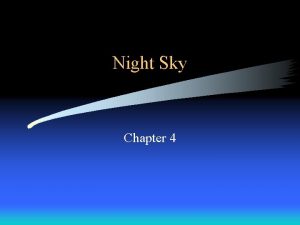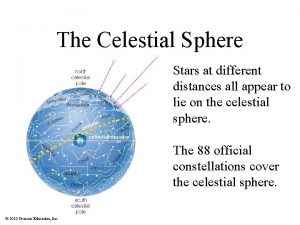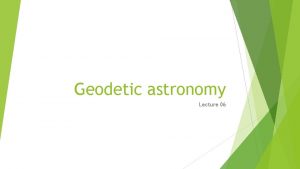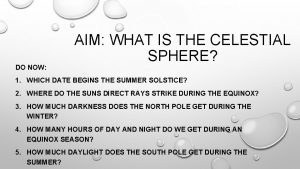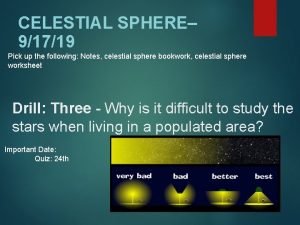1 The Celestial Sphere From our perspective on


































- Slides: 34

1 The Celestial Sphere From our perspective on Earth the stars appear embedded on a distant 2 -dimensional surface – the Celestial Sphere.

2 The Celestial Sphere Although we know better, it is helpful to use this construct to think about how we see the night sky from Earth.

3 A Personal Perspective: Horizon and Zenith Horizon

4 A Merry-Go-Round Perspective Our observing platform both spins daily and orbits the Sun once a year producing a complicated perspective

5 The Key to Understanding the Night Sky For a given observer the Earth blocks ½ of the sky at any instant. The key is understanding which half. . which depends on The observer's location on the Earth The time of day/night (which way the Earth is turned relative to the Sun) The time of year (which part of the Sky is washed out by daylight). d

6 Getting Oriented: Which Way is “Up”? Leaving the “flat Earth” of everyday perspective behind, “up” is the direction away from the center of the Earth

7 Getting Oriented: What Defines the Horizon? Zenith Horizon

8 Getting Oriented: What defines the “Horizon” Each individual observer has their own personal local horizon. In simplest terms this horizon is a flat plane tangent to the Earth at the observer's location. The giant observer below is misleading. For an observer of proper size the Earth would block ½ of the sky, defining the horizon.

9 Getting Oriented: Which way is “North”? Point in the direction of the North Pole. As you move your finger up into the sky from the horizon you are defining the northern sky. The observer below is facing south and seeing the southern stars up in the sky.

10 Altitude and Zenith Altitude

11 The Sky You Can See Depends Upon. . . Your location on the Earth As the Earth spins on its axis you get a tour of the sky. Exactly what part of the sky depends on how far North or South of the Equator you are.

12 The Sky You Can See Depends Upon. . . Your location on the Earth If you are standing at the North pole you will only see the Northern half of the sky all of the time. The turning Earth does not give you access to the southern sky.

13 The Sky You Can See Depends Upon. . . Your location on the Earth If you are standing at the Earth's equator you get a tour of the entire sky as the Earth turns.

14 The Sky You Can See Depends Upon. . . Your location on the Earth Most observers are somewhere between the pole and the equator. Portions of the sky are visible to them all of the time There are parts of the sky that they can never see.

15 The Key to Understanding the Night Sky For a given observer the Earth blocks ½ of the sky at any instant. The key is understanding which half. . which depends on The observer's location on the Earth The time of day/night (which way the Earth is turned relative to the Sun) The time of year (which part of the sky is washed out by daylight.

16 The Sky You Can See Depends Upon. . . The time of day or night Our clocks are referenced to the Sun's position in the sky. Noon is when your longitude on Earth is pointed at the Sun Midnight is just the opposite

17 The Sky You Can See Depends Upon. . . The time of day or night Our clocks are referenced to the Sun's position in the sky. When you are on the “day” side of the Earth you cannot see the stars. When you are on the “night” side you can.

18 Sunset To the Sun Midnight Noon Sunrise

19 The Key to Understanding the Night Sky For a given observer the Earth blocks ½ of the sky at any instant. The key is understanding which half. . which depends on The observer's location on the Earth The time of day/night (which way the Earth is turned relative to the Sun) The time of year (which part of the sky is washed out by daylight).

20 The Sky You Can See Depends Upon. . . The time of year The Sun washes out the stars in the daytime sky, so the Sun effectively hides a good fraction of the sky from view. The Earth shifts position relative to the Sun throughout the year, reaching the same point in its orbit on the same calendar date.

21 Reference Points on the Celestial Sphere Extend the Earth's poles and equator onto the sky and you have defined the celestial poles and celestial equator.

22 The Celestial Poles The “North Celestial Pole” lies overhead for an observer at the North Pole and on the horizon for an observer on the Equator The altitude of the pole equals your latitude.

23 The Celestial Poles The “North Celestial Pole” lies overhead for an observer at the North Pole and on the horizon for an observer on the Equator The altitude of the pole equals your latitude. To Pole

24 The Celestial Poles The “North Celestial Pole” lies overhead for an observer at the North Pole and on the horizon for an observer on the Equator The altitude of the pole equals your latitude.

25 The Celestial Poles The “North Celestial Pole” lies overhead for an observer at the North Pole and on the horizon for an observer on the Equator The altitude of the pole equals your latitude.

26 The Celestial Poles The rotating Earth makes it look like the Celestial Sphere is spinning about the celestial poles. http: //www. atscope. com. au/BRO/warpedsky. html

27 Polaris In the Northern Hemisphere there is a star, not all that bright, near the North Celestial Pole. It resides at the end of the handle of the “Little Dipper” and is called Polaris (for good reason – at least for now)

28 In the Southern Hemisphere there is no good pole star (at present). Note that there are some stars (near the pole) that never set below the horizon - “Circumpolar Stars” For an observer at the North or South pole every star is circumpolar. At the Equator there are no circumpolar stars Polaris

29 Precession Because the Earth is a spinning top, the direction of its pole in the sky is fixed (at least from the perspective of a human lifetime). Of course, this consistency of tilt is related to the cause of the seasons.

30 Precession Over long periods of time, the direction of the Earth's pole drifts in the same way it does for a child's top or gyroscope. The drifting of the axis of a top is called “precession”

31 Precession It takes 26, 000 years for the Earths pole to trace out a full circle on the sky. That circle is 47 degrees in diameter (2 x 23 ½)

32 Precession It takes 26, 000 years for the Earths pole to trace out a full circle on the sky. That circle is 47 degrees in diameter (2 x 23 ½)

33 Precession Different stars occupy different positions above the Earth's pole over time. Polaris is currently getting further from the pole every year. Just how long will we hang on to it as our pole star? ? ?

34 Consequences of Precession Different Stars are circumpolar at different times. 3000 years ago the Big Dipper was circumpolar at our latitude. Stars that currently never rise above our Southern horizon will be visible. The Southern Cross will be visible from Charlottesville in 10, 000 years. Go home and prove it for yourself with Starry Night!
 Lance simms
Lance simms Sphere of influence vs sphere of control
Sphere of influence vs sphere of control One point perspective door
One point perspective door Silo perspective vs business process perspective
Silo perspective vs business process perspective Tristan tzara biografia
Tristan tzara biografia Sees the celestial
Sees the celestial Querido padre celestial
Querido padre celestial Phaethon
Phaethon Directional distribution hair
Directional distribution hair Cantos de apocalipsis
Cantos de apocalipsis Celestial alignment
Celestial alignment Centered celestial object
Centered celestial object Padre celestial al entrar en mi lugar de trabajo
Padre celestial al entrar en mi lugar de trabajo Hoy nace una clara estrella
Hoy nace una clara estrella Celestial dwarf
Celestial dwarf Pathfinder shooting star
Pathfinder shooting star Celestial event
Celestial event Padre celestial al entrar en mi lugar de trabajo
Padre celestial al entrar en mi lugar de trabajo Padre celestial al entrar en mi lugar de trabajo
Padre celestial al entrar en mi lugar de trabajo Celestial objects
Celestial objects Padre celestial al entrar en mi lugar de trabajo
Padre celestial al entrar en mi lugar de trabajo Sede perfeitos como vosso pai
Sede perfeitos como vosso pai Deus nosso pai celestial
Deus nosso pai celestial Celestial bodies context clues
Celestial bodies context clues Trisagio celestial
Trisagio celestial Celestial nocchiero
Celestial nocchiero Sr 71 star tracker
Sr 71 star tracker Padre celestial al entrar en mi lugar de trabajo
Padre celestial al entrar en mi lugar de trabajo Los 24 ancianos se postran
Los 24 ancianos se postran Awareness of ourselves and our environment is:
Awareness of ourselves and our environment is: Our census our future
Our census our future Awareness of ourselves and our environment is
Awareness of ourselves and our environment is Our census our future
Our census our future Awareness of ourselves and our environment is
Awareness of ourselves and our environment is Christ be our light bernadette farrell
Christ be our light bernadette farrell





